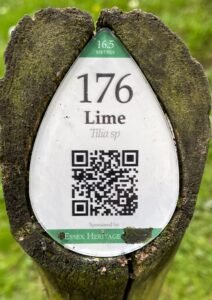Lime, Common
The Common Lime, a hybrid between small-leaved and large-leaved lime, is a broadleaved deciduous tree, that can grow to a height of 40m, and may live for 400 years.
The bark is pale grey-brown and irregularly ridged, with characteristic large burrs and leaf shoots at the base of the tree. Twigs are slender and brown, although they become red in the sun..

Photo supplied by:
Common Name:
Common Lime
Scentific Name:
Tillia europaea
Tree No:
176
Location:
F3

Leaf buds are red, with one small scale and one large scale, resembling a boxing glove, and they form on long leaf stalks.
The leaves are dark green, heart-shaped and flimsy, measuring 6–10cm in length. They are lopsided and lobed at the base. Leaves are more or less hairless, except for creamy-buff or white hairs on the underside of the leaf between the joints of the veins. In autumn, leaves fade to a dull yellow before they fall.

Credit: This could be your image
When in flower in June the Lime tree produces an unforgettable scent of summer and together with the hum of bees attracted to it, makes its flowering an eagerly awaited event.
Limes are hermaphrodite, meaning both the male and female reproductive parts are contained within one flower. Flowers are white-yellow with five petals and hang in clusters of 2–5.

Credit: This could be your image
Once pollinated by insects, the flowers develop into round-oval, slightly ribbed fruits, with a pointed tip.

Credit: This could be your image
Common lime is native to the UK and much of Europe. It occurs in the wild in scattered areas wherever the two parent species are located. It is more common in urban areas and parks.
Lime leaves are eaten by the caterpillars of many moth species. They are very attractive to aphids, providing a source of food for their predators, including hoverflies, ladybirds and many species of bird. Bees also drink the aphid honeydew deposited on the leaves. The flowers provide nectar and pollen for insects, particularly bees.
Long-lived trees provide dead wood for wood-boring beetles, and nesting holes for birds.
Lime wood is soft and light, white-yellow and finely textured. It is easy to work and often used in wood turning, carving and furniture making. The wood does not warp and is still used today to make sounding boards and piano keys. Limes can be coppiced and used for fuel, hop-poles, bean sticks, cups, ladles, bowls and even Morris-dancing sticks. The most common use of common lime is as an ornamental tree.
Optional Content.
Tree Listings
Lucombe Oak
Oak, Lucombe The Lucombe Oak, is a large spreading semi-evergreen tree, that can grow to a height of over 20m, and may live for 240 years. The bark is thick and corky and is fire resistant. Branches on older trees can be quite chunky. The buds are brownish, ovate...
Holme Oak
Oak, Holme The Holm Oak, is a broadleaf evergreen tree, that can grow to a height of over 20m, and may live for 400 years. The crown is broad, domed, with ascending branches and often with low stems. The bark is black and finely cracked, and the twigs are slender and...
English Oak
Oak, English The English Oak, the majesty of the woods, is a broadleaved deciduous tree, that can grow to a height of 40m, and may live for 1,000 years. This species grows and matures to form a broad and spreading crown with sturdy branches beneath. Photo...
English Oak
Oak, English The English Oak, the majesty of the woods, is a broadleaved deciduous tree, that can grow to a height of 40m, and may live for 1,000 years. This species grows and matures to form a broad and spreading crown with sturdy branches beneath. This tree was...
Red Maple
Maple, Red The Red Maple, is a striking broadleaved deciduous tree, that can grow to a height of 20m, and may live for 200 years, although 80 to 100 years may be more typical. This tree was planted in memory of Mr Hungerford Rowley, a long and respected resident of...
Red Maple
Maple, Red The Red Maple, is a striking broadleaved deciduous tree, that can grow to a height of 20m, and may live for 200 years, although 80 to 100 years may be more typical. Photo supplied by: Alan PayneCommon Name:Red Maple Scentific Name:Acer rubrum Tree...
Norway Maple
Maple, Norway The Norway Maple, is a broadleaved deciduous tree, that can grow to a height of 25m, and may live for 150 years. The bark is grey with fine ridges, and the twigs are slender and brown with tiny white spots. Photo supplied by: Alan PayneCommon...
Norway Maple
Maple, Norway The Norway Maple, is a broadleaved deciduous tree, that can grow to a height of 25m, and may live for 150 years. The bark is grey with fine ridges, and the twigs are slender and brown with tiny white spots. Photo Supplied By: Alan PayneCommon...
Field Maple
Maple, Field The Field Maple, is a sturdy broadleaved deciduous tree, that can grow to a height of 20m, and may live for 350 years. The bark is light brown and flaky, and twigs are slender and brown and develop a corky bark with age. Small, grey leaf buds grow on long...
Horse Chestnut
Horse Chestnut The Horse Chestnut, with its shiny mahogany conkers, is a broadleaved deciduous tree, that can grow to a height of 40m, and may live for 300 years. The bark is smooth and pink-grey when young, which darkens and develops scaly plates with age. Twigs are...
English Elm
Elm, English The English Elm, is a deciduous tree, that can grow to a height of 30m, and may live more than 100 years. The bark is grey-brown, rough and fissured, often with suckers growing from the base of the trunk. The twigs are finely hairy. Photo supplied...
Lawson Cypress
Cypress, Lawson The Lawson Cypress, is an evergreen conifer, that can grow to a height of 45m high, and may live more than 500 years. A tall, narrowly conical tree, with feathery foliage. The bark is cracked into vertical plates, and the twigs are a dark...